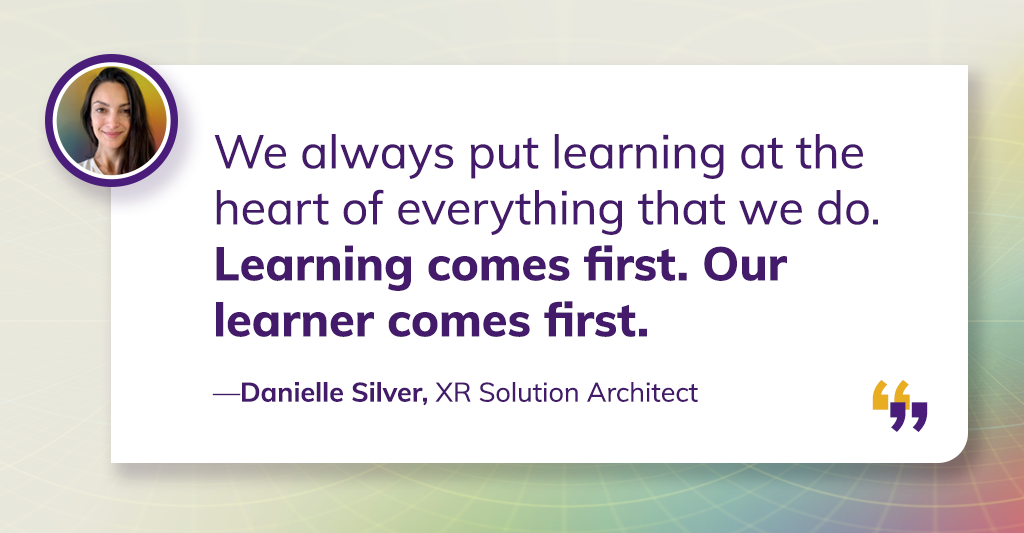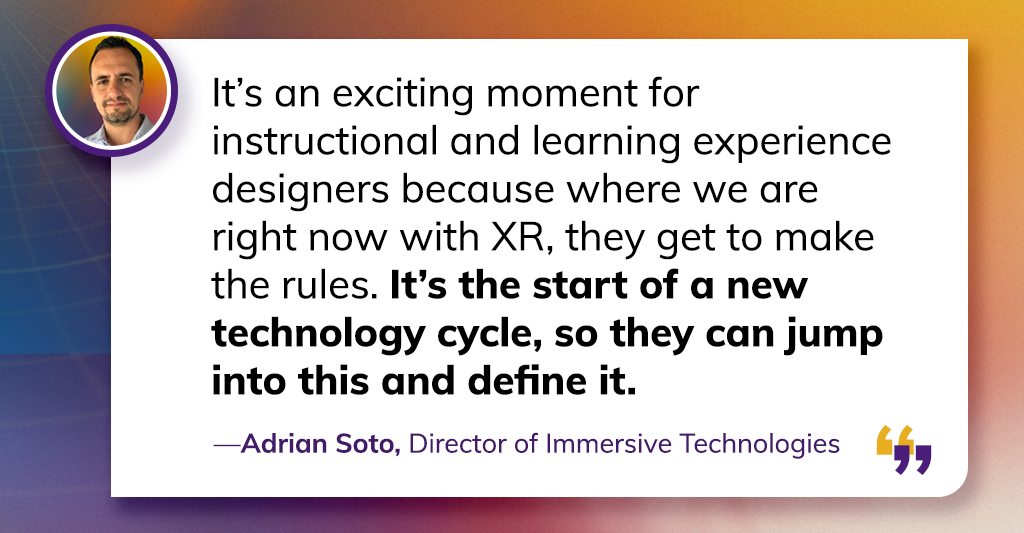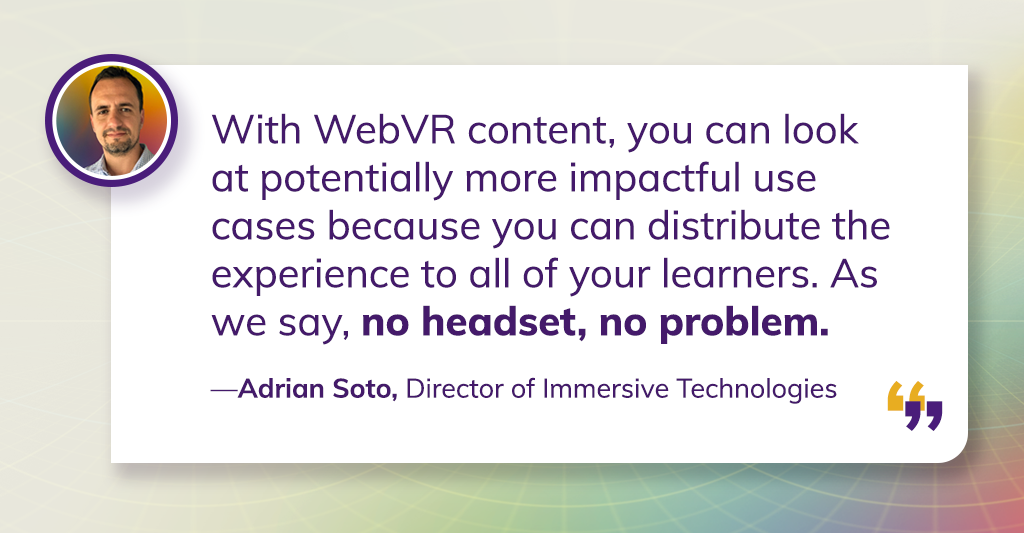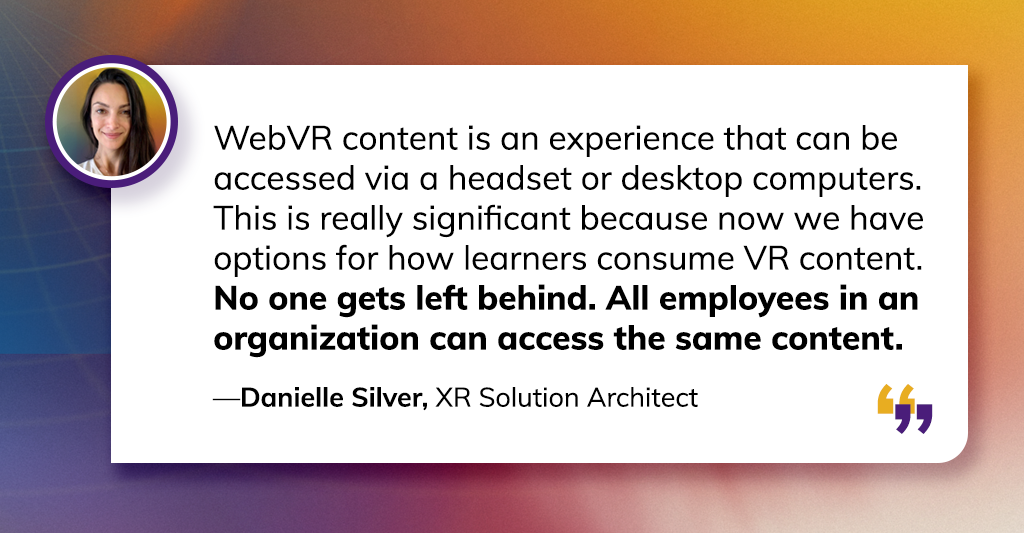An interview with Adrian Soto, Director of Immersive Technologies, and Danielle Silver, XR Solution Architect
The promise of immersive learning using XR technologies has been building for several years—and it’s now at a massive pivot point with the revamp of WebXR. WebXR is solving the challenges of validating and scaling VR, making these immersive experiences available to large audiences with or without a headset.
And that’s just one thing you need to know about XR and immersive in 2023. We talked with immersive learning experts Adrian and Danielle to get their insights.
What’s the state of XR and immersive learning in L&D right now?
Danielle: From a technology perspective, XR has matured to a point where it’s more familiar. Headsets are easier to access than even two years ago. In the past, VR was thought of as a novelty—something cool and shiny to add to a learning portfolio to get attention or simply increase engagement.
But now, our clients have realized the value of XR. They’re saying, how can we integrate immersive technology more intentionally? We’re finding the use cases that really shine as a VR application, where people apply what they’ve learned and put their skills to the test. This is often part of a learning journey where knowledge-based content will be eLearning or video, and then VR is the skills application.
What are the use cases for XR that clients are seeking out?
Danielle: In the past, we were seeing predominantly technical training use cases. Imagine a manufacturing environment where using your body for hands-on practice in a safe environment can offer incredible ROI—faster time to proficiency and fewer errors, which can be very unsafe and expensive. And this is still a great use case for VR.
But now we’re seeing interest in immersive technology across a whole spectrum of use cases, from human skills, DEIB (diversity, equity, inclusion, and belonging), and leadership to those harder technical skills. Think about things like onboarding, a day in the life, empathy-based experiences. One of the powers of virtual reality is putting yourself in the shoes of another and getting to explore different perspectives.
We’re now able to track how people are responding in challenging situations, like delivering and receiving feedback, or having difficult conversations. Not just the words they’re using but the sentiment that they’re using as well in their tone. That’s really powerful for both skill-building and assessment.

One of the big challenges learning leaders face is understanding, vetting, and creating a strategy to pilot and adopt new learning technologies. How do you consult with clients and help them navigate this?
Adrian: We try to meet clients where they are when they come to us. It’s easy to get overwhelmed as you start your research. There’s so much information out there. We also talk to folks who are starting from zero. We’ve put a lot of effort into translating our research and knowledge about these technologies into the language of L&D, and creating workshops and ways clients can experience XR.
The technology is proven now. It works. So the question we’re helping clients with is, how is my organization going to adopt it? We’re helping them design a strategy or a roadmap. Not to become early adopters but to become embracers of this technology and really understand what it means for learning.
XR seems to evoke a combination of excitement and confusion—wanting to get these new tools to learners but not knowing where to start. How might instructional and learning experience designers think about getting started if they’re overwhelmed?
Danielle: Technology is always changing and will continue to change. What stays somewhat the same is the science of learning and the principles of adult learning. If you have a solid understanding of how your audience likes to learn and what strategies you can use to impact knowledge, retention, and behavior change, that’s 80% of what you need to know. Technology is 20%.
The biggest adjustment is shifting away from linear learning experiences, your “click next to continue” learning. Even branching scenarios are somewhat linear in an eLearning scenario. Now you’re moving to the 3D volumetric space where the branching “nodules” are endless.
Making this shift is completely attainable, and the first step is experiencing it yourself, then starting to understand how this technology works and how to leverage it in your design. Using your foundation in human-centered design and learning science is essential.

What does the design and development experience look like for XR? What can clients expect?
Danielle: It’s really a new level of collaboration. The first part of our job is equipping clients with the information they need to make informed decisions about the experience. For example, a 360-degree filmed experience versus a CGI experience. We center on the learning objectives and talk about the nuances and design trade-offs. We empower them so together we make the right decisions for their learners.
Production is a very iterative process. It’s agile-informed and inspired. There are design sprints and every two weeks there’s something to show. Clients have their hands in the project as much as we do. They’re interacting with the experience, giving us feedback. This way of working creates a high level of trust.
There are lots of authoring tools emerging for XR. What do learning leaders need to consider as they decide whether to build capabilities in-house or outsource to a vendor?
Adrian: We’re starting to see a democratization of this technology, and that’s a good thing. The more creators we have experimenting and adopting XR pushes all of us forward. All authoring tools have their features and limitations. So the question is, what is your learning objective and what type of content do you want to, and need to, create to make effective learning?
Just like with eLearning, you can create at a certain level with these tools, and creativity and an innovative mindset will serve you. And just like eLearning, when you start moving toward the higher end with games and simulations, you start needing a bigger team to create that content.
It’s the same with XR. The higher the complexity, if you want a richer, more engaging experience, you’ll need technical artists, developers. Maybe you want to track analytics. As the complexity increases, you need a bigger team with more specialized skills. You’ll reach an inflection point where you have to decide if it’s justifiable to do this in-house or go to a company that lives and breathes this work every day. At this stage of the industry, it probably makes sense to outsource if this is the level of experience you’re looking for.
What about WebVR content? What is it and how is it changing the game for XR learning?
Danielle: WebXRt is an experience that can be accessed via a headset or desktop computers. This is really significant because now we have options for how learners consume VR content. No one gets left behind. All employees in an organization can access the same content.
Obviously, the headset version is more immersive. You are completely immersed in the 3D volumetric space. But the desktop version is pretty spectacular and engaging. And it’s so much easier to scale. Especially in a hybrid work environment where not everyone is in the office.
If you’re not yet ready to invest in thousands of headsets, but you know that VR is something that you want to explore, WebXR is a great starting point. You can create a proof of concept or prototype and test it out with your audiences.

Adrian: I think a question that someone might have is, why is WebXR such an important thing now when it wasn’t in the past? It has a lot to do with the evolution of the technology. It’s a first step we didn’t have before that will allow more companies to get into VR learning.
When you’re a large, global company, the business case for investing in headsets is challenging. Your use cases are constrained to the size of the audience you can get headsets for. Now that constraint is removed. You can look at potentially more impactful use cases because you can distribute the experience to all of your learners. As we say, no headset, no problem.

VR opens up a whole world of data that hasn’t been possible before. What data can you track in VR and how is that useful for learning?
Adrian: There are so many possibilities here; it’s really up to your creative power to determine what you want to track. The technology is very flexible. Where and when are you looking at something? How long did it take you to interact with something? Did you grab it or not? How fast did you do something?
We think about how data can serve everyone. For stakeholders, they want to see how VR improves outcomes compared to other ways of learning. The issue becomes how to feed the LMS with that information. They’re not set up to receive that level of data. So we’ve created a tool we call the Analytics Dashboard to visualize the data for clients.
And data can also enhance the learning with real-time feedback. For example, we’re doing voice analysis for practicing communication and language skills. We can give learners feedback right away on their projection, tone, and pronunciation. We can track hand and body movements for safety training and help learners make adjustments to keep them healthy and safe. Eye movements, heart rate. With new headsets, the technology is becoming available to track cognitive load. Imagine what that means for adaptive learning.
What about budgets? What should clients expect to invest as they get into this space?
Danielle: Our approach is to be consultative, strategic partners to our clients. The decisions we make together are based on learning objectives and creating a successful and scalable learning solution. That means making decisions about complexity. Making thoughtful and intentional decisions that help us keep costs in check.
We’ve created three categories of experiences, from passive observation to semi-active with more agency to fully active. We center on the learning objective and determine what type of experience will be most effective. And we’ve created pricing levels for each category, so there are options for how to get started.
We know the value of having a social component within a learning experience, whether that’s an instructor or learning from your peers. Is that a possibility with immersive technologies?
Adrian: Absolutely. We’ve been able to do that for quite some time now with multi-learner experiences. This could be learners sharing the same virtual space or having an instructor there to observe, guide, and give feedback. They can even control the experience, for example, resetting an exercise, calling everyone to attention, or triggering a new variable to make the experience more challenging.
If you’d like to find out more about WebXR, XR, and immersive learning, it would make our day to hear from you. Get in touch through our website or reach out directly to Danielle Silver at [email protected].




